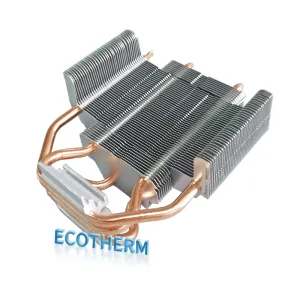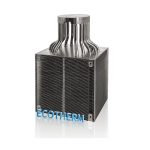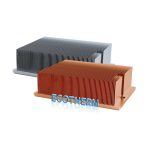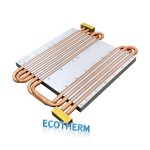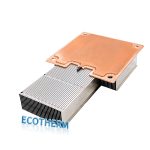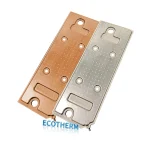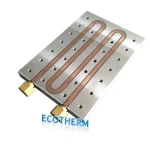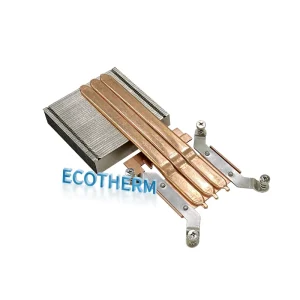Heatsink Solutions for High-Performance Components: Custom Cooling for CPU, GPU, SSD, and More
CPU Cooling Foundations: From Basics to Flagship Solutions (heat sink cpu / cpu heatsink)
As the heart of computing devices, CPUs generate significant heat under heavy load. If not efficiently dissipated, this heat can cause severe throttling or even damage the processor. The CPU heatsink is a core component designed to address this issue.
Basic Air Cooling:
The most common form of heat sink cpu is a base made from high thermal conductivity metals (like aluminum or copper) that tightly contacts the CPU lid, with dense fin arrays to maximize surface area. One or more fans force airflow through the fins to quickly dissipate the heat. The efficiency of this setup depends on factors like base material, heat pipe configuration, fin design, and fan pressure/flow.
Advanced Solutions:
As CPUs’ TDP (Thermal Design Power) continues to rise, basic aluminum extrusions no longer suffice. More efficient heat pipe cpu coolers have become mainstream. These coolers incorporate multiple vacuum-sealed heat pipes inside, with a special working fluid that evaporates on the hot end, carrying heat away to the cooling fins. This phase change heat transfer method is far more effective than pure metal conduction, significantly enhancing cooling performance.
Flagship Performance:
For top-tier processors (like HEDT platforms or overclocked CPUs), vapor chamber cpu coolers represent the pinnacle of air cooling technology. The vapor chamber operates on similar principles as heat pipes but uses a flat, two-dimensional vacuum cavity with capillary structures and working fluid inside. This design enables near-uniform temperature distribution and rapid heat diffusion, providing superior thermal performance, especially for handling localized CPU hotspots. Vapor chamber cpu coolers are the ideal choice for users seeking ultimate quiet operation or extreme cooling.
type of custom heat sinks
Guardians of SSD High-Speed Performance: NVMe Heatsinks (heatsink ssd)
NVMe SSDs offer exceptional read/write speeds via PCIe channels, but their controllers and NAND flash chips generate significant heat. Sustained high temperatures can trigger thermal throttling, drastically reducing performance, or even accelerate component aging.
Thermal Challenges:
M.2 NVMe SSDs are compact, with limited self-cooling capability. During heavy file transfers, video editing, or gaming, temperatures can easily skyrocket.
Solution:
The installation of heatsink ssd or an SSD with a pre-installed heatsink is crucial. These heatsinks, usually made of aluminum or copper, are tightly attached to the SSD’s main controller and NAND chips using high-conductivity thermal paste or pads. The design maximizes surface area (often through fin arrays) and takes advantage of airflow within the case to rapidly dissipate heat. Using a heatsink ssd ensures sustained high performance and prevents data loss due to overheating.
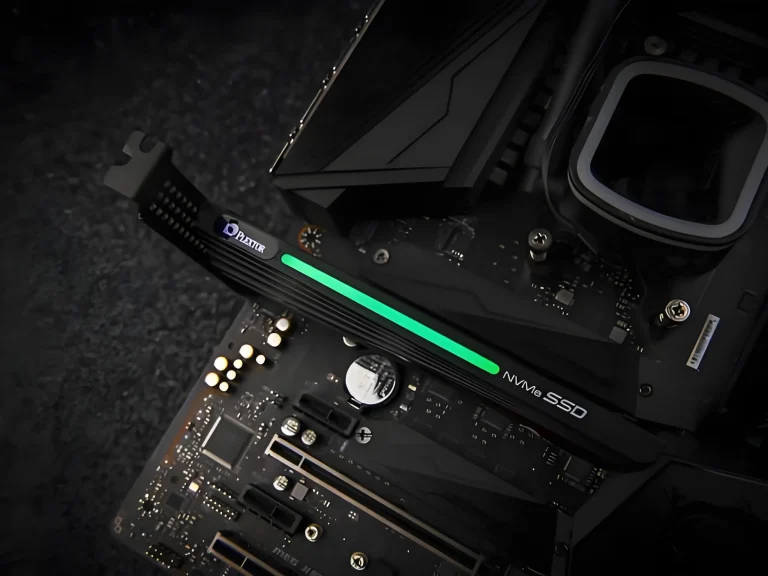

Invisible Guardians of Communication Stability: Antenna Heatsinks (heatsink antenna)
High-power, high-integrated antenna modules, such as those in 5G base stations, Wi-Fi 6/6E/7 routers, and satellite communication devices, generate considerable heat during operation. Temperature directly affects RF circuit stability, signal gain accuracy, and component lifespan.
Cooling Design:
Heatsink antenna solutions are specially designed to match the antenna’s form and heat source distribution. Typically made from lightweight, thermally conductive aluminum alloys, they are precision-cast or CNC-machined to ensure good thermal contact with heat-generating components like the power amplifiers (PAs) inside antennas. Key considerations include maximizing cooling efficiency, minimizing wind resistance (for outdoor or forced-air environments), and ensuring electromagnetic compatibility (EMI).
Why It Matters:
Effective heatsink antennas are crucial for maintaining stable operation and minimizing failure rates in communication systems.
Efficient Cooling for Power Electronics: IGBT Cold Plates (igbt cold plate)
IGBT (Insulated Gate Bipolar Transistor) modules are essential components in power conversion devices like inverters for electric vehicles (EVs), industrial frequency converters, UPS power supplies, and solar/wind power converters. These modules, operating under high voltage and current, generate considerable heat.
Cooling Challenges:
IGBT modules often have large baseplates that require low thermal resistance and efficient cooling for high-density heat dissipation. Liquid cooling solutions, particularly IGBT cold plates, have become essential for high power density applications.
Solution:
The IGBT cold plate is the core of a liquid cooling system. Made from high-conductivity materials like copper, these plates are precision-engineered with optimized cooling channels (parallel, serpentine, or jet flow designs) to ensure even and efficient heat transfer. Coolant circulates through these channels, removing heat from the IGBT module and delivering it to the external radiator. An IGBT cold plate maximizes heat exchange, reduces flow resistance, and provides even cooling, ensuring reliable operation of high-power electronics.
Core Cooling for Graphical Computation: GPU Water Cooling Plates (gpu water cooling plate / gpu heat sink)
High-end GPUs, used in gaming, professional design, and AI research, generate immense power and heat. Traditional air cooling often falls short, especially under heavy load, leading to high noise levels and thermal bottlenecks.
Liquid Cooling Advantages:
A large gpu heat sink with multiple fans may suffice for basic cooling needs, but it often fails under extreme overclocking, small form factor cases, or when minimal noise is required.
Water Cooling Core:
The GPU water cooling plate is the heart of liquid cooling systems for GPUs. Made from highly conductive metals like copper or nickel, the plate ensures perfect contact with the GPU core and its surrounding components, such as VRAM and power MOSFETs. Fine microchannels etched into the plate allow coolant to flow over the hot metal surface, efficiently carrying away heat. Compared to air cooling, the gpu water cooling plate delivers superior heat dissipation and minimizes system noise, providing a more stable and cooler environment for GPU performance.
>>>>Confused about cooling solutions? Ecotherm offers custom cold plate services.
Temperature Control for High-Performance ESCs: ESC Water Cooling Plates (esc water cooling plate)
Electronic Speed Controllers (ESCs) in drones, electric RC models, e-scooters, and EVs are crucial for controlling motor speed. High-power ESCs generate significant heat due to MOSFET losses, and overheating can lead to reduced efficiency or failure.
Cooling Needs:
In high-performance drones or electric vehicles, ESCs often operate in compact spaces and harsh environments (e.g., high-speed drone flight). Air cooling may be inadequate or unstable.
Solution:
ESC water cooling plates are the ideal solution for these high-power applications. Integrated directly into the ESC or attached closely to the heat-producing components, these cooling plates circulate coolant to evenly remove heat and maintain optimal temperatures for reliable performance.
The Heart of Liquid Cooling for High-Performance PCs: Water Cooling Plates & System Solutions (pc water cooling plate)
For PC enthusiasts aiming for extreme performance, overclocking potential, or silent operation, liquid cooling systems (AIO or Custom Loops) have become the go-to choice, surpassing traditional air cooling.
Key Component:
The PC water cooling plate is the crucial interface between high-heat components like CPUs and GPUs and the water cooling loop. It uses precision-machined metal bases to ensure perfect contact with the heat source, with microchannel designs that maximize heat transfer efficiency.
System Integration:
A complete pc water cooling system includes the pump, reservoir, tubing, radiator, and fans. The quality and installation of the pc water cooling plate directly influence the entire system’s performance, providing superior cooling and lower operating noise compared to top-tier air cooling systems.
Temperature Management for the Future: Battery Cooling Plates (battery cooling plate / ev battery cooling plate)
The performance, lifespan, and safety of electric vehicle (EV) batteries are tightly linked to their operating temperature. Overheating or uneven temperature distribution can cause severe issues.
Cooling Challenges:
Maintaining batteries within an optimal temperature range (typically 20-35°C) is critical for performance and longevity.
Solution:
Battery cooling plates, especially EV battery cooling plates, are widely used in electric vehicles to ensure efficient thermal management. These plates, often made from lightweight, corrosion-resistant aluminum alloys, are integrated into the battery modules or sandwiched between cells. They use optimized coolant flow paths (serpentine, parallel, or other designs) to evenly distribute heat, ensuring balanced cooling and quicker thermal response than air cooling. Liquid-cooled systems also help pre-heat the battery in cold conditions, improving efficiency and accelerating warm-up.

